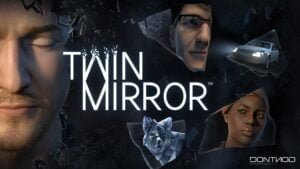(Reviewed on Xbox Series X by Games of DAYNE)
Forging the legacy of a viking has never been more satisfying in the series’ most photorealistic world to date
The twelfth main entry in the franchise takes place amidst the backdrop of the Viking invasion of Britain in all of its beautifully brutal glory. Assassin’s Creed: Valhalla retreads familiar gameplay territory, taking elements that have worked in recent entries while also reintroducing a more stealth based approach and adopting the most grounded narrative experience since the days of the first few titles.
As a launch title for the new generation of consoles, the series has never looked or felt better than Assassin’s Creed: Valhalla. Embracing the power of the new generation, this experience is perhaps the most visually impressive that a console has seen to date. The extremely large and stunning environment is a treasure trove for exploration, adventure and conquest. With the player able to choose between a male or female Eivor, which can be switched almost instantly at any time, Eivor’s role in this Viking epic has a commendable focus on customisation that falls short significantly in the loot department that is likely to alienate fans of Origins and Odyssey in particular.
Eivor of Ravensthorpe
Assassin’s Creed: Valhalla opens with a harrowing tragedy that leaves Eivor an orphan after their settlement is raided by Kjotve the Cruel. A small handful of Eivor’s Raven Clan escape and Eivor grows up as the adoptive child of King Styrbjorn, growing close with his son Sigurd.

18 years pass and Eivor’s attempt to exact revenge upon Kjotve fails though the retrieval of Eivor’s fathers axe bestowed upon him a vivid vision of Odin. Revealing the vision to local mystic Valka who induces another vision on Eivor of a large wolf and Sigurd with one arm, interpreting this as a prophecy that will eventually see Eivor betray him.
Cursed with this prophetic vision that Eivor refuses to believe will come to pass, Sigurd returns from a two year voyage with a pair of foreigners, Basim and Hytham of the Hidden Ones and gifts Eivor the iconic hidden blade. After finally exacting revenge on Kjotve for the murder of Eivor’s parents, Sigurd’s father King Styrbjorn pledges allegiance to King Harald in support of his plan to unite Norway into one kingdom. Infuriating Sigurd, he, Eivor and a handful of other clan members leave on a voyage to England to found their own kingdom.

Settling in an abandoned village in Mercia which they dub Ravensthorpe, Eivor and Sigurd’s expansion into England begins and the tale that unfolds sees Eivor travel across the country forging alliances, making pledges to every territory to secure support for their clan. Explore and conquer sit at the root of the premise of the narrative and what follows is quite possibly the most grounded story the franchise has told since the likes of the first few Assassin’s Creed titles.
Grounded in political turmoil, swaying allegiances and the looming prospect of Eivor’s vision of betraying Sigurd coming to fruition through escalating tension, conquering England dominates the narrative. The Order of the Ancients that will go on to become the Templar Order play a prominent role in the political power struggle, proving to be adversaries just as deceptive and manipulative as fans of the series have come to expect.

As has become standard with the franchise, the advanced civilisation that pre-dates humanity, the Isu, plays a part in key moments that alter the trajectory of Eivor’s saga in Valhalla with some game changing moments hitting hard at the very end of the story. Surprisingly, the present day storyline featuring Layla who has served as the protagonist of this timeline in both Origins and Odyssey is almost entirely abandoned until the games climax.
After doing such great work re-establishing the significance of the present day timeline since the death of Desmond in Assassin’s Creed III, it is such a shame to see her absence for almost the entire experience. Admittedly, her presence is incredibly powerful in the final moments of Valhalla’s narrative though it’s hard to justify her absence that precedes it after her prominence in the previous pair of entries.
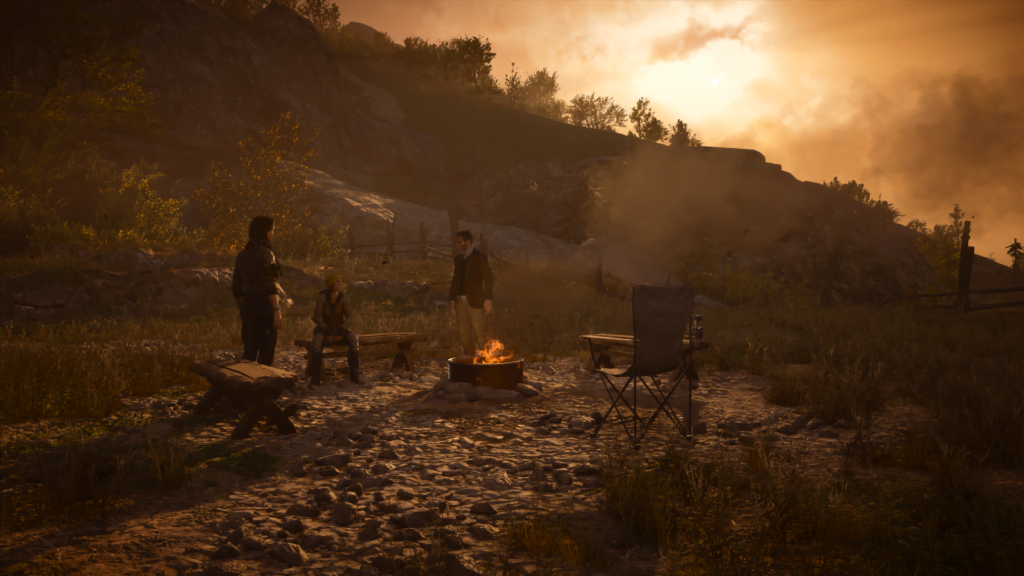
Brutal beauty
Following on with the deeper combat as seen in Origins and Odyssey as opposed to the earlier entries in the franchise, further refinement has made the combat the most satisfying the series has ever seen. Mastery of parrying and evasion provides a more strategic approach than simply hacking and slashing. Eivor is able to equip a weapon in each hand including the likes of swords, hammers and axes. Shields can also be equipped which are just as useful offensively as defensively.

Some weapons require 2 hands though a skill can be acquired to allow dual wielding of 2 handed weapons for ultimate devastation. Unfortunately, there are not many weapons available and only a handful can actually be purchased. Most weapons are found throughout the world and a player that focuses on story with minimal exploration is likely going to only have less than a dozen before they start exploring heavily as was my experience.
A pair of legendary weapons are hidden in the world that require a series of tasks, collectibles or pre-requisites to obtain. These are Thor’s Mjolnir hammer and King Arthur’s Excalibur sword. These are incredibly powerful and very fun to use, a great pair of weapons that fit within the realm of the mythology tied to the land and the era of Assassin’s Creed: Valhalla.

Most enemies have a stun meter above their health bar which when depleted leaves them open for an execution finisher. Depending on the weapons the player and the enemy possesses, these are varied and oh so glorious. Ripping an enemies spear from their hands and impaling them with it, chocking them with their maces or ripping their heads off is incredibly satisfying. Known for their brutal and merciless combat, the violence of the Vikings is well represented in Eivor’s combat prowess.
Enemy soldiers of the varying factions are the only threats to Eivor as the wildlife can be just as lethal. Bears, mountain cats and ferocious boars are just a few examples that are interested in eviscerating Eivor on sight. Mythological beasts and Alpha beasts are also tucked away waiting to be found that will test the player’s abilities unlike any other. These beast boss battle type encounters are challenging, fun and rewarding.
Health does not regenerate and instead relies upon the consumption of berries from the wilderness or food in camps. Upon consumption of certain amounts of food, the excess contributes to Rations which can be stored and used to replenish health when it is low. The amount of Rations that can be stored can be increased through customisation.
YOUR Eivor
Customisation for Eivor is an improvement from Odyssey as far as being able to customise hair style and colour, and facial hair for male Eivor, though these are fairly restricted to a small assortment. The inclusion of tattoos that can be placed on the face, chest, back and each arm is cool and certainly allows players to have their Eivor look, to a degree, how they want.
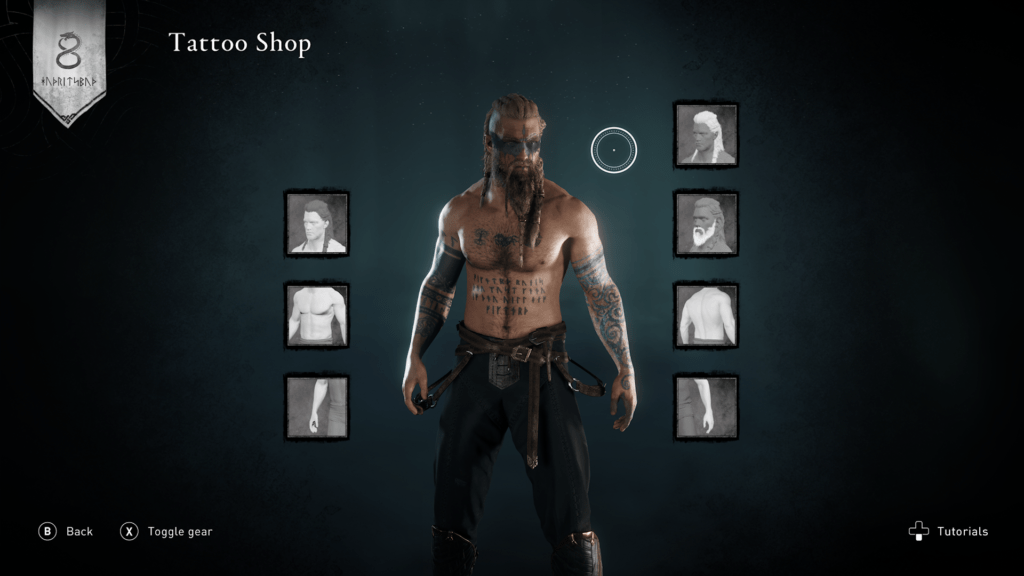
Gear has taken a significant backseat when compared to Odyssey. No longer will the player constantly find new gear to equip in the form of helmets, boots, gloves, cloaks and shirts for example. Instead, somewhere in the neighbourhood of two dozen sets are available. Wearing more pieces of the same set applies boosts to various stats that can be worthwhile.
This approach to the gear as loot means a player has very little variety of they are just focusing on story, thus encouraging exploration with the reward of customisation options. Players like myself that like to absorb the story first before really digging into the world will have an extremely low amount of gear to switch between before committing to exploration.
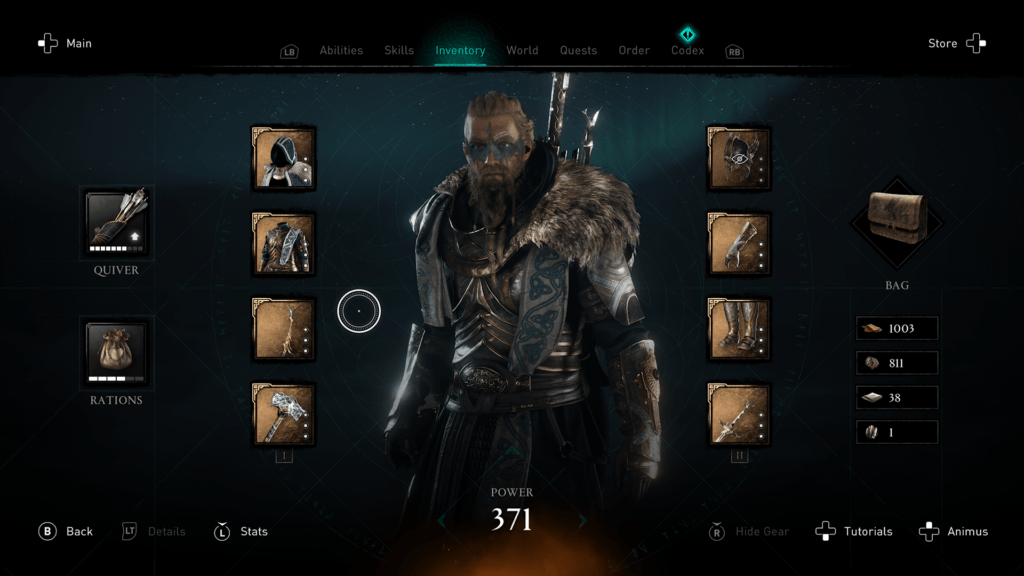
Gear can be enhanced in rank at Ravensthorpe and upgraded as far as stats are concerned in the inventory using resources found in the environment. As with weapons, gear can also have Runes applied. Runes can be found, collected from killed enemies or bought from merchants and these offer a large variety of stat boosts to the player such as health, increases heavy damage or assassination damage to name a few. Enhancing the rank of the gear in Ravensthorpe is required to increase the number of Runes that can be applied, with a maximum of three slots per item.
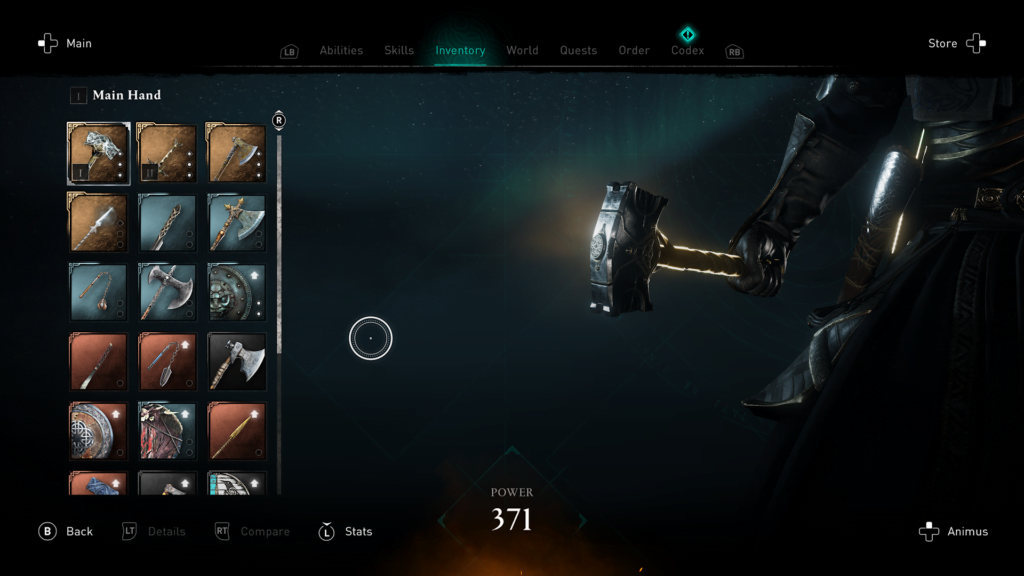
Ravensthorpe itself, which serves as the main hub of the game world, can be upgraded by building different shops or huts. These are built using supplies found in the environment or by raiding outposts. Buying the tattoo shop for example allows the player to customise Eivor’s tattoos and hair, buying the fishing hut gives players access to a fishing rod that can be used to fish and majority of the other building types award increases to the feast buff. The feast can be triggered in Ravensthorpe by ringing a bell, at the end of the feast a buff is applied that increases various stats such as attack and health for a duration.

Eivor’s raven Synin can have alternates skins purchased including a pigeon that can be equipped from the Stables and Aviary at Ravensthorpe when it has been constructed.
The horse too has a variety of skins and Valhalla’s online store allows for Haiti, a large white wolf to be purchased as a microtransaction, alternatively available in the more expensive versions of the game. The customisation of these animals, particularly being able to use a different species, is fun and allows for a more personalised approach to the pair of animals that Eivor will spend a significant amount of time with.
Mastering the environment
Eivor has a beautiful world to explore and most of it is going to require platforming and environmental puzzle solving to fully experience. Eivor’s raven Synin can be controlled to take a look at the environment from up high though its abilities are significantly less useful than the previous two entries.
Synin’s ability to hone in on mission objectives is ridiculously underpowered when reflecting back on Odyssey. No longer can the player locate their objective from up high but instead a generous green radius is presented that hides the objective inside. This requires a boots on the ground exploration type that only feels like a negative in the context of the perhaps overpowered ability of the bird in Odyssey or even Origins.
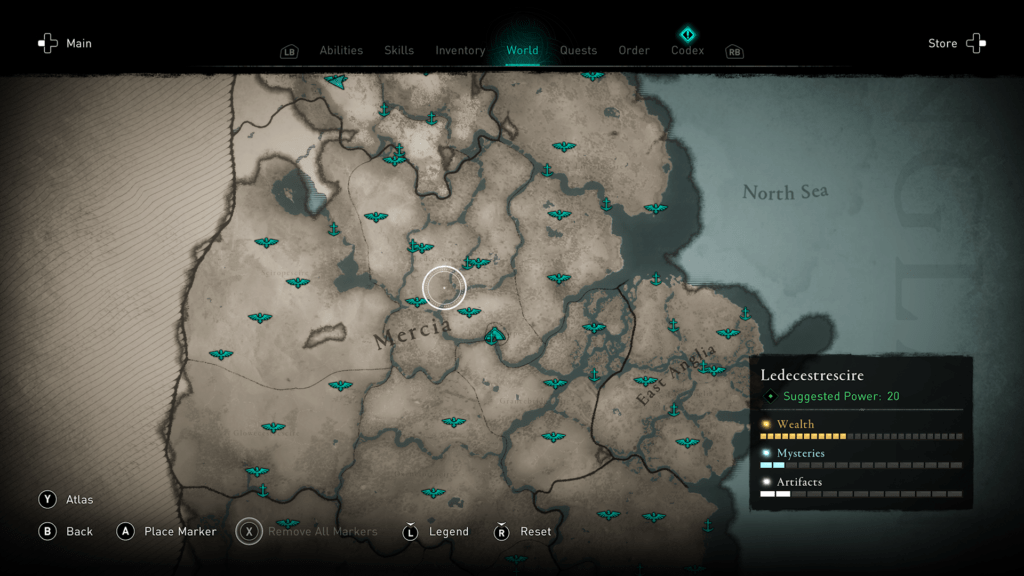
Fast travel between unlocked synchronisation points is very fast, especially on an Xbox Series X when compared to an Xbox One X. This alleviates the burden of the never ending backtracking required, with it never feeling intrusive or time consuming. Unlocking synchronisation points as they are come across is highly recommended to increase the efficiency of exploration and reduce the amount of riding time. Though with such an immersive world to explore, there is certainly nothing wrong with soaking it all in on horseback.
Got skills?
An interesting alternative to the skill tree found in Odyssey is present in Valhalla. Instead of being able to see future skills and base your decision on which skills to pursue, Valhalla has the rather large skill tree shrouded in smoke. Skill points earned through leveling up can be spent on stat boosts such as increased melee attack damage, health, or fire resistance for instance.
Skills can only be unlocked if the one prior to it has been unlocked and each branch contains a singular passive ability or perk such as the ability to dual wield two handed items or rapid fire certain bows. Once a certain point of the skill branch has been unlocked, the first node of an attached branch will open up, clearing that branch of its smoke and revealing the skills available.
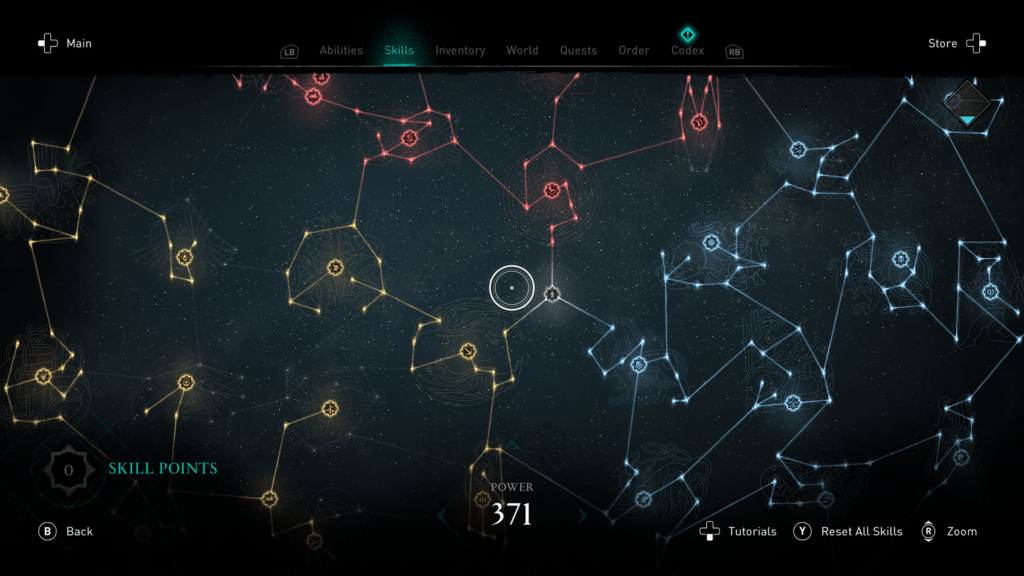
This approach makes it near impossible for players to customise their Eivor to their liking without significant progression, with some amazing and useful abilities that may go unfound until deep into the endgame. Luckily, individual or all skill points can be reset with no in-game cost that allows for some exploration of the skill tree before committing to a particular path.
The lack of transparency hurts early players though once the story is complete and thorough exploration is being taken to complete the insane amount of optional tasks, it becomes much easier to at least have each branch revealed and the player can slowly chip away at which one will lead to an ability they desire.
More than a story
Assassin’s Creed: Valhalla offers a lot more than the main quest line. Throughout the main story and after there are a large number of optional side missions to keep the player busy. Presented in a formula much different to previous titles in the series, these side missions are typically single objectives and can be completed very quickly. Gone are the multi-objective quest lines and instead presented as less intrusive and distracting.
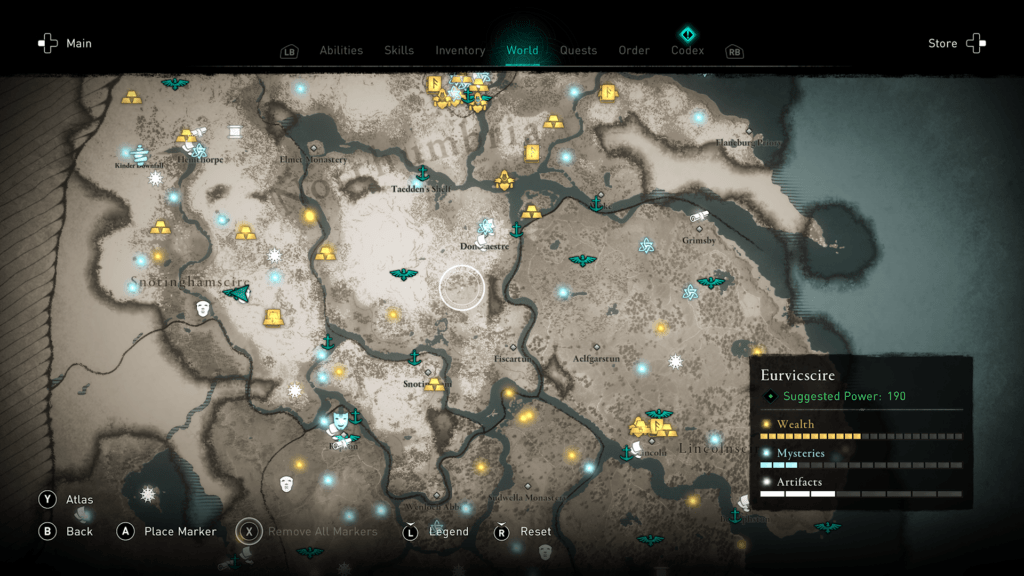
Majority of the available side missions are encountered as World Events. These are incredibly brief and certainly don’t lack in variety. Escort missions, brawls, hunts and fetch quests are present but so too are missions that see a couple insist Eivor to burn everything in their hunt in exchange for a key to a loot chest or drinking a suspicious brew to communicate with a pig. The weird and wacky nature of a number of these World Events bring levity and humour to a rather stern narrative that offer a nice change of pace amid the chaos.
The world map in Valhalla is full of Synchronisation points that when synchronised reveal over 800 icons that indicate things to do. Majority of these are glowing orbs that are either white, blue or yellow. White orbs are Artifacts, various collectibles that can be found and traded, used to find hidden treasure or required to solve puzzles in exchange for legendary rewards such as King Arthur’s Excalibur sword.
Yellow orbs are Wealth items which contain abilities, gear, weapons or resources and supplies used to upgrade gear or Ravensthorpe.
Blue orbs are defined as Mysteries and consist of World Event side missions, Cairns that require rocks to be stacked to certain heights, ritual offerings and standing stone puzzles where the likes of the iconic Stonehenge must be viewed at a particular angle to align symbols. Other special missions such as Alpha beast encounters or Animus Anomalies for instance, the latter bringing Layla from the present day into the world to solve platforming puzzles the reward the player with extremely brief glimpses into the Isu timeline.
Completing all of these Animus Anomalies provides an unbelievably epic hidden video that is an absolute treat for fans of the deeper mythos of Assassin’s Creed. I’ve just mentioned a few but there are so many unique types of encounters to discover with deep exploration.

Made to raid
Replacing the large scale Conquest Battles from Odyssey are Assaults. These require the player to breach gates, lower drawbridges and defeat bosses. These are a lot of fun, especially with the background showing Eivor’s reinforcements trying to knock down gates with battering rams that occasionally need protected and watching both sides brutally chop each other down. It’s chaos, it’s fun and their length is fair to prevent them overstaying their welcome.
Outside of Assaults, any location can be raided as Eivor’s clan can be summoned by the radial wheel on the D-Pad to provide assistance. Raids can also be initiated from the longboat by ramming it onto the shore with a button prompt. Aside from story missions and getting from point A to B, this is about the only use of the longboat as the naval combat has been removed. The longboat can also be summoned when near water with the radial wheel too and it can be reasonably customised in Ravensthorpe.

A marvel of exploration
There is an absolute abundance of things to do across the vast world that encourages exploration with its clever placing of optional objectives to lure players to every corner and every crevice. Several of the Wealth and Artifacts items are well hidden and require puzzle solving and environmental traversal to uncover, completionists will be looking in the neighbourhood of 100 hours to tick off everything on the world map that covers England, Norway, Vinland as well as the majestic mythological realms of Asgard and Jotunheim.
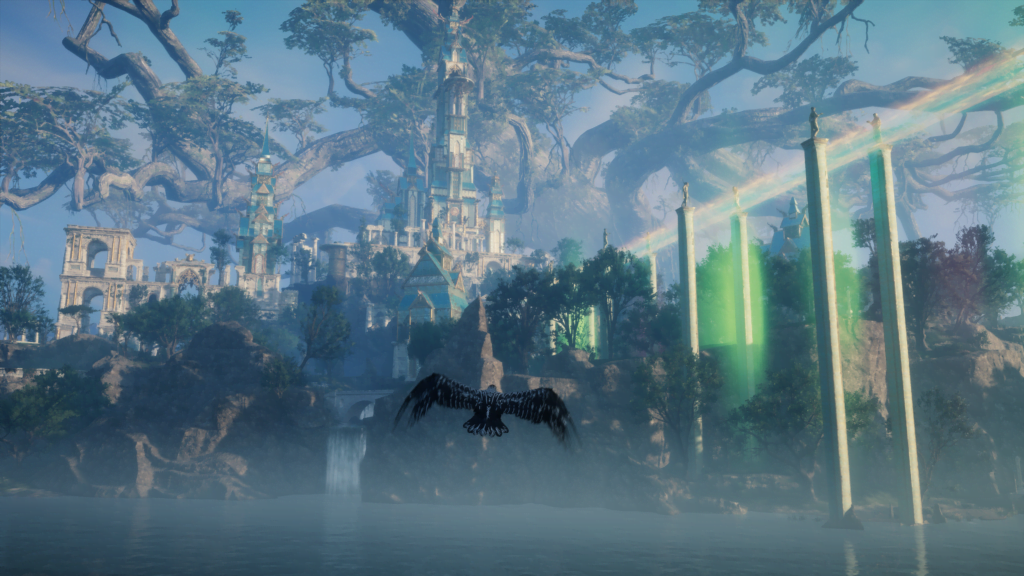
These locations are all incredibly stunning and overall Assassin’s Creed: Valhalla easily contains the most striking environmental design experienced on a console to date. The realism of the lighting and breathtaking sunsets and sunrises are jaw droppingly beautiful and the water is as serene and authentic as I have ever experienced. The character models themselves leave a little to be desired outside of the main characters and some suspicious lip syncing in particular hold the characters back from achieving a more genuine feel.
The music is beautifully appropriate featuring a score that knows its place with excellently dramatic beats while also containing more solemn, and haunting melodies when called upon. It’s masterfully woven into the cinematics in particular and the world never feels too quiet or as though it’s at odds with the story or scenery.

Is the latest Assassin’s Creed the best?
There’s no doubt going to be a lot of opinions among the community as to where Assassin’s Creed: Valhalla ranks when compared to the remainder of the series. With a narrative that is for the most part the most grounded since the first adventures of Altair and Ezio, the slower pace and political dominance may alienate players looking for a story as strong as Odyssey or Black Flag for instance. The puzzling loot situation is also a step back from the excellent variety found in the last few entries.

Aside from that, Assassin’s Creed: Valhalla has perhaps the most immersive world in the series, stunningly brought to life on the new generation of consoles in particular. Coupled with the the deepest and most engaging combat gameplay in the series to date and epic Isu and present day timeline revelations that are unfortunately held back until the very end, Valhalla gets a lot right.

Unfortunately the steps backward may hold it back from being the greatest entry into the series overall but for an action adventure RPG epic, Assassin’s Creed: Valhalla is a hell of a way to launch into the new generation. The series still has a lot left in the tank after this trilogy of reinvigorated mythology and this Norse adventure will easily satisfy fans of Assassin’s Creed and casual players alike.
+ Incredible environmental visuals
+ Overwhelming amount of things to do outside of story
+ Cool customisation of Eivor, including instant gender switching
+ Norse mythology well executed, especially Asgard and Jotunheim
– Story is very slow and political
– Limited gear and weapon options
– Raven is far less effective than Odyssey
Games of DAYNE Rating
* A review code was provided by Ubisoft for the purpose of this review courtesy of BG4G. *
– Additional links –
For more of my reviews, click HERE.
To see this review and other content from my associates at BG4G, click HERE.


